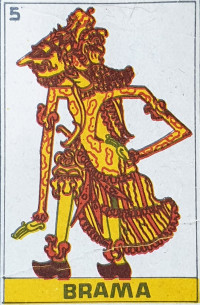Wayang Brama
The Divine Archer and Protector in Javanese Shadow Puppetry.
Within the vibrant world of Javanese wayang kulit (shadow puppetry), Wayang Brama emerges as a powerful figure known for his unmatched archery skills, unwavering loyalty, and divine origins. This article explores the many facets of Wayang Brama, delving into his mythology, significance within wayang stories, and his enduring legacy in Indonesian culture.

Divine Lineage and Heavenly Abode
Wayang Brama is often identified with Brahma, the Hindu god of creation. However, in Javanese wayang, he takes on a distinct character, sometimes depicted as the son of Sang Hyang Tunggal, the supreme deity. He resides in Kahyangan Manikmaya, a celestial palace adorned with jewels and radiating divine light.
Master Archer and Celestial Warrior
Brama is renowned for his extraordinary archery skills. He wields the powerful bow Gandivan and the infallible arrows Pasupati, capable of vanquishing even the most formidable foes. As a protector of dharma (righteousness), he plays a pivotal role in battling demons and maintaining cosmic order.
A Multifaceted Character
While primarily portrayed as a valiant warrior, Wayang Brama also embodies other qualities. He serves as a teacher and advisor to kings and heroes, offering wisdom and guidance. Additionally, he acts as a matchmaker, facilitating marriages between characters crucial to the narrative.
Epic Adventures and Enduring Significance
Wayang Brama features prominently in numerous wayang stories, including the Ramayana and Mahabharata. In the Ramayana, he aids Rama in rescuing Sita from the demon king Ravana. In the Mahabharata, he blesses Arjuna with exceptional archery skills, setting the stage for the climactic Kurukshetra battle. Beyond individual stories, Wayang Brama symbolizes justice, courage, and divine intervention. His image adorns temples and traditional artworks, signifying his cultural significance and connection to the spiritual realm.
Adaptations and Contemporary Relevance
While primarily performed in traditional wayang kulit shows, Wayang Brama has found expression in various contemporary forms. He appears in comic books, films, and even video games, showcasing his enduring appeal across generations.
Conclusion
Wayang Brama stands as a towering figure in Javanese wayang kulit, not just for his divine power and martial prowess but also for his embodiment of moral values and spiritual wisdom. His legacy continues to inspire artists, storytellers, and audiences alike, reminding us of the importance of justice, courage, and the ever-present struggle between good and evil.
Last updated